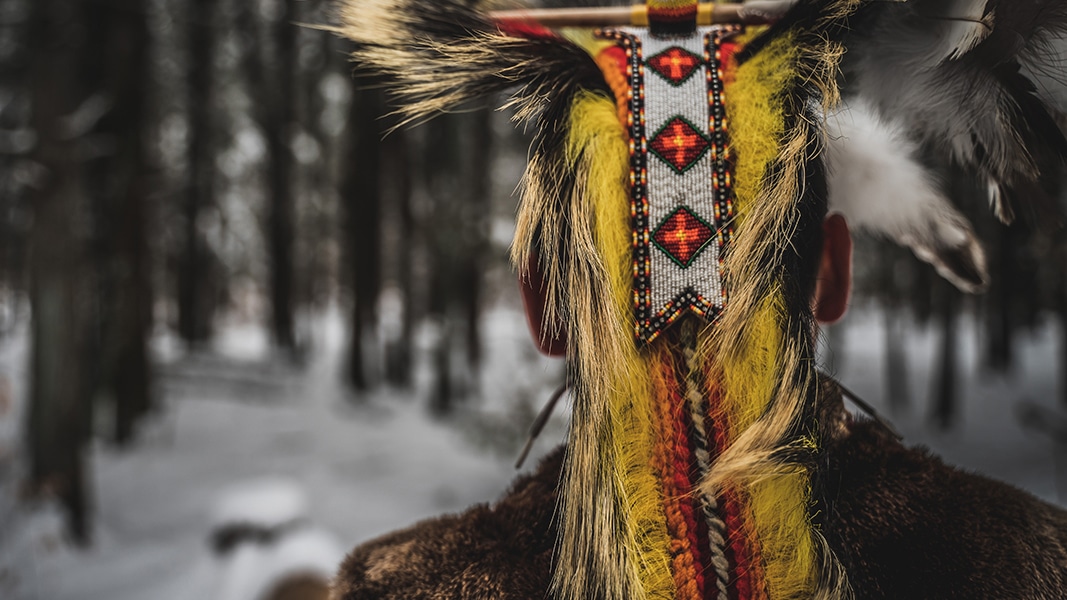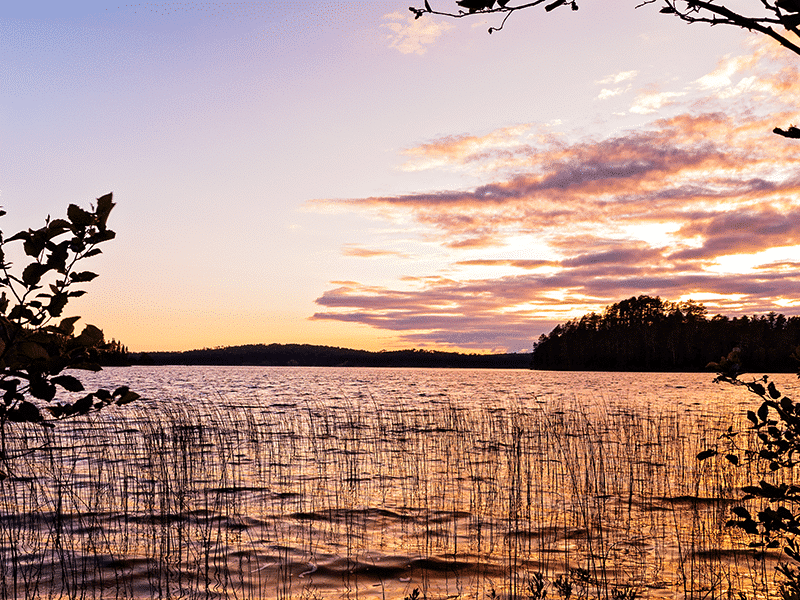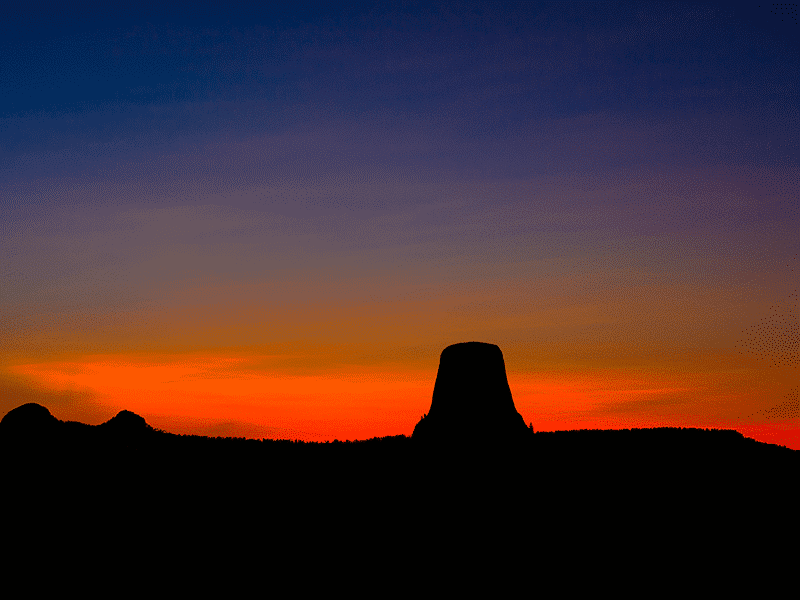The Menominee Indian Reservation in northeast Wisconsin is visible from space. It appears on Google Maps as a dark green square of wooded land, contrasting the lighter green patchwork effect of cultivated fields that surrounds it, and bleeding into the dark of the Chequamegon-Nicolet National Forest that borders it on the north.
Marcus Grignon, speaking from the reservation, is proud to point this out.
“All the surrounding land was Menominee land that we had to surrender in treaties, and it is all Big Ag — the soil is depleted year by year due to pesticides and chemical fertilizers,” he says. “On Menominee, we don’t use pesticides, herbicides, fungicides on our lands. We’ve allowed our forests to grow the way they are supposed to. We do controlled burns to allow early successional plants to come up and establish roots for the later successional plants. We work for a good environmental stewardship policy, make sure the land is taken care of for the future. We have to preserve Grandmother Earth for the seventh generation.”
But like many tribes, the Menominee are struggling to find their way economically in a country hit by crisis. The reservation has a logging mill (a tribal enterprise), but it has been repeatedly shut down by the pandemic. There is some cattle raising, and many homes have community gardens, growing corn and squash. Some on the reservation still gather wild rice on local waterways in the traditional way.
An Indigenous Perspective
Grignon is involved in first efforts at hemp cultivation as an alternative for the Menominee and other native peoples of Wisconsin. One plot was planted this June on tribal lands under lease to the College of Menominee Nation, a land-grant community college established in 1993. A second is on the Oneida Nation reservation west of Green Bay and to the south, where a cooperative is leasing land from the tribal government. Both are still in the research phase.

“We’re trying to develop our own seed variety for the Great Lakes region,” Grignon says. “Find out — does it grow eight or nine feet tall? What machinery is needed? We want farmers to be able to make informed decisions when the time comes. And we’re bringing an indigenous perspective on the research, so our ways of observational analysis will be accredited when it comes to hemp research in the future.”
The college has developed a Sustainability Leadership Cohort program, which is providing “a pipeline of high school students” into the hemp project. They are working the plot as interns, as well as learning about the rich history of hemp in Wisconsin.
The two plots are using Anka and Altair seed varieties purchased from Canadian sources approved under auspices of the Association of Official Seed Certifying Agencies, AOSCA. This body oversees the lineage and genetic bona fides of agricultural seed stock across North America.
Unfortunately, the harvest was delayed due to trouble coordinating with the state Agriculture Department to get samples tested and assure compliance with the federally mandated 0.3% THC limit.
“We’re now experimenting with hemp hurd, since we missed the optimum time for fiber,” Grignon says, believing the hurd can have applications in construction and insulation — as in the HempBlock and Hempcrete products now marketed in Canada and Europe. “We’re hoping to build a small structure soon.”
Carrying on John Trudell’s Legacy
Coordinating both the Menominee and Oneida operations is Grignon’s Hempstead Project Heart, founded in 2015 to promote hemp for American farms, especially across Indian country. The group, which Grignon directs, was awarded a grant for the current hemp project from the Native American Agricultural Fund.
The NAAF is a charitable trust created by the settlement of the landmark Keepseagle v. Vilsack class-action lawsuit, brought by Native American farmers seeking restitution for what they called generations of discrimination by the US Department of Agriculture. The case was settled in 2011, with the USDA agreeing to pay $760 million.
Grignon considers the Menominee-Oneida project a “feasibility study to show Native farmers the benefits of hemp cultivation in their crop rotation. We think this can be part of a foundation for Native farmers to thrive.”
He also sees a role in the hemp industry for urban Indians, who have migrated from Wisconsin’s reservations to Green Bay, Milwaukee, Madison or the Twin Cities. Grignon currently works part-time for the Happy Trails CBD store in Outagamie County, two counties south of Menominee.
“We need our people in agriculture, and we need people in other aspects of the hemp industry who are native,” he says.
Hempstead Project Heart was founded by the legendary Santee Dakota activist, poet, and recording artist John Trudell, who first came to fame in the 1970s as a leader of the militant American Indian Movement (AIM). Marcus flew to California to see John four days before his passing in December 2015. At that meeting, Trudell asked him to take the lead in Hempstead Project Heart and carry on his vision of hemp as key to ecological renewal in rural America and Indian country.
“John knew he was going and wanted somebody to take up the hemp torch and see that the vision is fulfilled,” Grignon says.
DEA Raids the Reservation
What first attracted Trudell’s attention to Menominee country was the raid of the reservation by DEA agents on Oct. 23, 2015. The agents destroyed what federal authorities said was a crop of illegal marijuana, and what tribal authorities said was a field of THC-deficient industrial hemp.
Then-acting US Attorney for the Eastern District of Wisconsin Gregory Haanstad said agents executed a search warrant and seized about 30,000 “marijuana plants” weighing several thousand pounds. But then Menominee tribal Chairman Gary Besaw flatly contradicted this. He said in a statement: “I am deeply disappointed that the Obama administration has made the decision to utilize the full force of the DEA to raid our Tribe. We were attempting to grow industrial hemp for research purposes in accordance with the Farm Bill.”
Besaw accused the White House of bad faith: “We offered to take any differences in the interpretation of the Farm Bill to federal court. Instead, the Obama administration sent agents to destroy our crop while allowing recreational marijuana in Colorado. I just wish the President would explain to tribes why we can’t grow industrial hemp like states, and even more importantly, why we don’t deserve an opportunity to make our argument to a federal judge rather than having our community raided by the DEA?”
In May 2015, the Menominee tribe had passed an ordinance legalizing cultivation of low-THC hemp under tribal licenses on its lands, citing text in the 2014 US Farm Bill that allowed hemp cultivation for research purposes. The plot was under cultivation by a Menominee family, on land leased from the tribal government.
According to Besaw’s statement, the tribe had engaged in numerous face-to-face consultations on its intention to grow hemp with the US Attorney’s office, as well as with Bureau of Indian Affairs (BIA) agents.
“What makes the actions taken today even more difficult is that the federal government is very aware of the great unmet needs of the Menominee,” said Besaw. “Menominee County ranks at the bottom of the state in poverty and health statistics. The Tribe is trying to meet those needs by researching the potential economic opportunities of industrial hemp just as Congress intended when passing the Farm Bill.”
The operative issue was tribal sovereignty. When the DEA raided the Menominee reservation, industrial hemp crops were being grown in Kentucky, Colorado, and a handful of other states in accordance (if not in compliance) with the Farm Bill. But the bill stipulated that the exemption from federal law only applied in states that permit industrial hemp cultivation. This did not include Wisconsin. The Menominee argued that they should be afforded the same respect as a sovereign entity enjoyed by the 50 states, with their right to grow hemp under terms of the Farm Bill recognized. The federal contention that the crop was marijuana rather than hemp was more a matter of politics than THC content.
A Sensitive Issue
Sovereignty is an especially sensitive issue for the Menominee. Menominee County is Wisconsin’s newest, having been created in 1959 after the Menominee tribe was “terminated” by federal law. In the so-called “Termination Era” of the 1950s, several tribes were dissolved as legal entities and usurped of their lands by federal legislation. The former reservation lands were at this time incorporated as Menominee County, and whites started moving in, creating a confusion of conflicting claims that persists to this day.
In 1975, amid the upsurge of American Indian activism and militancy, the tribe regained federal recognition and restoration of most of its reservation. Today Menominee County is essentially coterminous with the boundaries of the federally recognized Menominee Indian Reservation. The county and reservation share a common seat in the town of Keshena.
Marcus Grignon was an agricultural researcher with the University of Wisconsin at Green Bay when the Menominee tribe passed its hemp ordinance, and he helped oversee the test grow as part of a project supported by the American Indian College Fund. He recalls that the ordinance stipulated that cultivation must be undertaken in coordination with the College of Menominee Nation to conform to the limited terms of the 2014 Farm Bill. Wisconsin’s arch-conservative Gov. Scott Walker had just nixed the tribe’s bid to open an off-reservation casino, which would have supplemented income generated by the Menominee Casino Resort at Keshena. This raised the imperative for an alternative way out of the tribe’s economic straits.
Grignon recollects the events that led up to the raid in October 2015. “The feds had already come out to the land and checked out the crop, back in July when it was a foot tall. We said, ‘We have a government-to-government relationship with you guys, we’re doing it by the law.’ But for the rest of summer they kept coming onto the land without tribal police accompaniment, taking pictures. It was kind of scandalous.”
“Days before raid, the US attorney came in with a device to test samples,” he continues. “They all came back negative. But the week we wanted to harvest, they came in to throw their weight around. They took samples and left, and then said the samples they took were hot, above the THC limit — but they never showed us the test results, they never shared them with tribal leaders. All those plants had seeds in them, we were going to use that seed for the next year’s crop and develop our genetics. But that didn’t happen.”
A Menominee lawsuit against the DEA over the raid was dismissed by a federal judge in May 2016. Again, the case did not turn on THC content, but sovereignty. District Judge William Griesbach in Green Bay accepted the argument of a Justice Department attorney that the term “state” in the 2014 Farm Bill only applied to Wisconsin, not Indian tribes — and Wisconsin law at that time did not permit growing hemp for any purpose. He wrote, in a seeming self-contradiction: “While Wisconsin law is not enforceable on the Menominee Reservation, that does not change the fact that the growing or cultivating of industrial hemp is not allowed under the laws of the State of Wisconsin.”
The Tangle of Sovereignty Law

These dilemmas are rooted in the unique status of federally recognized Native American lands. Under a doctrine established by two Supreme Court decisions concerning the Cherokee in 1831 and 1832 — together known as the Cherokee Indian Cases — the Native American nations are not “foreign nations” but “domestic dependent nations,” with limited sovereignty on lands “held in trust” for them by the federal government. Under this so-called “trust doctrine,” it is the federal government, and not the states, that shares power with the tribes on these lands.
The Indian Citizenship Act of 1924 clarified that Native Americans are US citizens, with the right to vote, and the Indian Reorganization Act of 1934 established the formal tribal governments.
Most federally recognized reservations (there are a few only recognized by state governments, which fall outside the “trust doctrine”) consist of “trust lands,” those formally owned by the federal government (more specifically, by the Interior Department), and “fee lands,” those bought by the tribal governments and appended to the reservations.
The Menominee reservation was established by an 1848 treaty with the US government, and the tribe’s hunting and fishing rights (on and off the reservation) were explicitly acknowledged in return for further ceded lands in a second treaty in 1854.
But their situation has been complicated by two factors. One was the tribe’s 18 years of “termination” that formally began in 1958.
The other was Public Law 280 of 1953, which allowed state governments to have criminal and civil jurisdiction on tribal lands in Wisconsin, Minnesota, Nebraska, California, and Oregon. This was opposed by tribal governments at the time, who protested that they had not been consulted.
The legal effects of both these measures have now been largely reversed. PL 280 remains on the books, but Wisconsin retroceded jurisdiction over the Menominee Reservation back to the feds when the tribe’s federal recognition was restored in 1975.
Broken Promises
In the intervening years, however, much damage was done. Federal aid that had been promised in compensation for ceded territories under the 1848 and 1854 treaties was cut off with termination, and the tribal government no was longer recognized as a sovereign entity. The tribe’s hydropower system was dismantled, the turbines and machinery sold off. “We lost our hospital that Indian Health Services was paying for, and the off-reservation hospital often didn’t even respond to emergency calls,” Grignon relates.
The tribe also lost its rights to hunting, fishing, and rice harvesting on off-reservation lands and waters, most critically, the Wolf River. These rights were only restored when the Menominee took the matter to the Supreme Court and won in 1968 — establishing that treaty rights cannot be extinguished through termination.
The reservation lands themselves were broken up into private parcels with termination — setting off a chaotic scramble for property. “My dad’s generation said it was lawless at the time, there was no oversight, nobody knew who was in control,” Grignon says. “It was a dark time for a lot of Menominee. You had a generation that didn’t pass on a lot of tradition they got from their parents. There was a gap in the cultural transmission. We’re trying to get it back now, but we have a lot of catching up to do.”
Since restoration, the tribe and county have existed side by side, with their jurisdiction divided depending on whose citizens are at issue — enrolled tribal members (numbering some 4,000) or the few hundred white settlers who mostly moved in during the termination period.
A plan to mine for sulfides in the Wolf River basin, which could have degraded traditional Menominee lands and waters, was only defeated this year, when the company pulled out in the face of environmentalist opposition.
These complications posed both challenges and opportunities when the Menominee emerged at the forefront of efforts to restore Wisconsin’s hemp economy.
Forgotten History
Wisconsin has a proud legacy of hemp production — although the history was nearly forgotten for two generations before being rediscovered and brought to light by advocates.
In the opening years of the 20th century, the newly formed US Department of Agriculture especially promoted the industry in the state. The early Agriculture Secretary Jeremiah Rusk, himself a former Wisconsin governor (and Civil War hero), established an Office of Fiber Investigations, which oversaw test plots in the Badger State.
By 1920, Wisconsin was the country’s leading hemp producer, growing more than all the other states combined. It was so profitable that the industry even survived passage of the Marihuana Tax Act in 1937, with farmers simply paying the exorbitant taxes imposed on the crop. The industry boomed under the USDA’s wartime “Hemp for Victory” program, which provided tax exemptions and even subsidies. Some Wisconsin farmers would even tell historians that the industry again survived, if briefly, the end of World War II and cut-off of the subsidies — that it was only the advent of cheap synthetic fibers in ‘50s that finally ended hemp cultivation in the state.
It was, in large part, Hempstead Project Heart and the Menominee that have worked to revive this history over the past years — even if Native Americans had been largely excluded from hemp wealth back during the boom. And they perceived that their unique jurisdictional status could provide a legal opening to revive production in the state.
In 1970, the Controlled Substances Act superseded the Marihuana Tax Act, making cannabis formally illegal (rather than de facto illegal under an onerous tax burden). The first crack in the edifice of federal prohibition was the 2014 Farm Bill, which allowed small hemp plots for research purposes in states that approved it.
The 2014 Farm Bill did not mention Indian tribes, but later that same year the Justice Department issued the Wilkinson Guidance Memorandum, which suggested leniency “in the event that sovereign Indian Nations seek to legalize the cultivation or use of marijuana in Indian Country.” This was building on the previous year’s Cole Memorandum, issued in response to the successful marijuana legalization initiatives in Colorado and Washington state and similarly calling for a tolerant approach — but not explicitly mentioning Native American jurisdictions.
However, the Wilkinson memo was clear that it was only “guidance” for enforcement, that nothing in its text “alters the authority or jurisdiction of the United States to enforce federal law in Indian Country.”
By planting hemp on the reservation, the Menominee challenged that. “We said we were going to do it on our own sovereignty,” Grignon says.
And that’s what they argued when they challenged the legality of the DEA raid in federal court. Grignon portrays this as a strategic gamble. “If we had argued that the college had the right to conduct research as institution of higher education, I thought we’d have won,” he says. “But a ruling for the Menominee on sovereignty grounds would have set a precedent for other (non-PL 280) tribes to oversee hemp cultivation on their lands.”
Compromise with USDA
On Nov. 30, 2017, Gov. Walker finally signed legislation allowing hemp cultivation for research purposes, as permitted by the 2014 Farm Bill. This was the fruit of a lobbying effort by the Menominee and farmers across the state.
“We worked with farmers in the area to make hemp legal again,” Grignon says. They eventually got the Wisconsin Counties Association on their side, as well as the Wisconsin Farmers Union and state Farm Bureau. “That was the one that got the Republicans to perk up,” Grignon recalls, referring to the Walker administration and the governor’s GOP allies who then controlled the state house.
Then came the 2018 Farm Bill, which legalized commercial cultivation of hemp — under either state regulation or direct USDA regulation. This new Farm Bill did mention tribal sovereignty, although not in relation to hemp per se. Provisions for Native American participation in USDA conservation and forestry programs were largely the result of pressure from the Native Farm Bill Coalition, launched by the Shakopee Mdewakanton Sioux Community of Minnesota.
But for nearly a year after passage of the Farm Bill in the closing days of 2018, Native American farmers were left in the lurch. While most farmers could legally operate under state regulations for hemp cultivation, would-be growers on federally recognized Indian reservations had to wait on issuance of USDA regs. Until then, they were effectively barred from growing hemp in spite of the change to federal law. It wasn’t until the end of October 2019 that the USDA finally issued its “Domestic Hemp Production Program.” Then, there was a 60-day public comment period before it took effect.
But in May 2019, the USDA, at least, had issued a policy statement “clarifying” that it interprets the 2014 Farm Bill to mean that “an Indian tribe can enter into a partnership or contract with an institution of higher education or a State department of agriculture” to establish hemp cultivation for research purposes. The Menominee jumped on this, and amended their 2015 Hemp Ordinance to allow state regulation — which is why their crop was tested by the Wisconsin Agriculture Department, not the USDA. Grignon calls this a voluntary “government-to-government relationship” between the Menominee and the state of Wisconsin.
Meanwhile, the Menominee are preparing a regulatory plan to submit to the USDA for approval, allowing them to cultivate commercially under the 2018 Farm Bill.
Grignon views accepting either state or federal regulation as a necessary compromise — at least for now. “I wish we didn’t have to deal with the USDA when it comes to hemp production on tribal land. We push for full sovereignty as much as we can.”
He does count as a victory that the USDA regs allow tribal governments as well as states to submit their plans for approval. For the states, this means farmers operating under their plans can qualify for USDA aid packages. For the tribes, it additionally means they can grow hemp under their own oversight, albeit with USDA sign-off.
An Example for Hemp Farmers
The USDA has thus far approved plans for several tribal governments, including the Colorado River Indian Tribes in Arizona, the Fort Belknap Indian Community in Montana, the Iowa Tribe of Kansas and Nebraska, the Cheyenne & Arapaho Tribe of Oklahoma, and the Yurok Tribe, Santa Rosa Cahuilla and La Jolla Band of Luiseno Indian Tribes of California.
When the USDA accepts their hemp regulation plan, Grignon says the Menominee’s government-to-government accommodation with Wisconsin will “expire.”
It wasn’t until Nov. 26, 2019, that the state’s new Democratic Gov. Tony Evers signed a law approving commercial cultivation of hemp in Wisconsin. But when the Menominee move to commercial cultivation, it will be under their own regulatory authority.
The Menominee crop has faced a challenge from Japanese beetles, and Grignon says they are exploring “integrated pest management” methods to get the problem under control without resorting to chemical pesticides.
Grignon is nonetheless determined — not only to make hemp work for the Menominee and Oneida, but for their efforts to serve as an example for farmers countrywide.
See other articles in the Hemp & Native American Sovereignty series.
Bill Weinberg, a Project CBD contributing writer, is a 30-year veteran journalist in the fields of drug policy, ecology and indigenous peoples. He is a former news editor at High Times magazine and produces the websites CounterVortex.org and Global Ganja Report. © Copyright, Project CBD. May not be reprinted without permission.
Recommended Readings
Growing a Cannabis Economy on White Earth
Part 2 of a 5-part series on hemp and Native American sovereignty.
Standing Up in Lakota Country
Part 3 of a 5-part series on hemp and Native American sovereignty.
Showdown at Navajo Nation
Part 4 of a 5-part series on hemp and Native American sovereignty.
Closing the Circle
The final installment of a 5-part series on hemp and Native American sovereignty.





